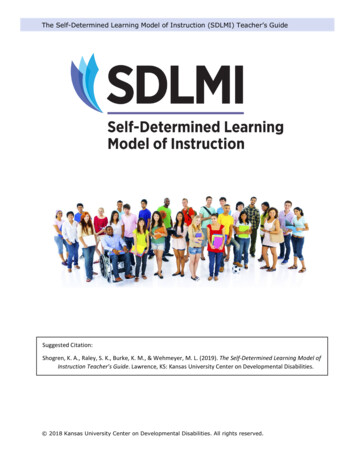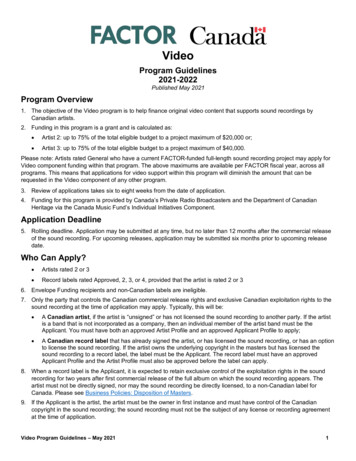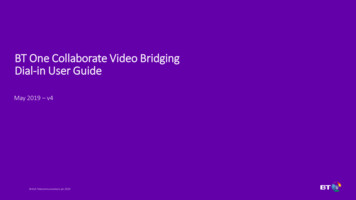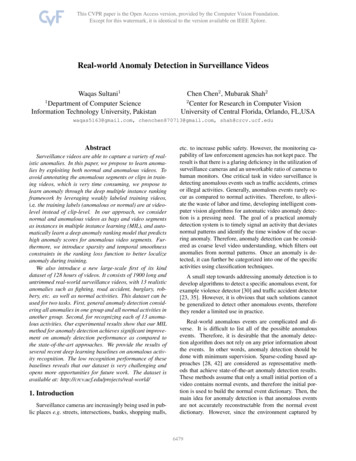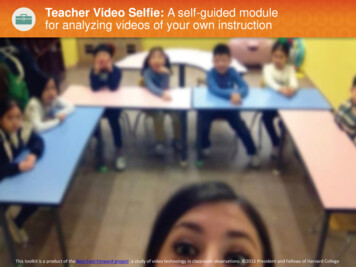
Transcription
Teacher Video Selfie: A self-guided modulefor analyzing videos of your own instructionThis toolkit is a product of the Best Foot Forward project, a study of video technology in classroom observations. 2015 President and Fellows of Harvard College.
You’ll Learn To watch yourself with purposeTo highlight priority evidenceTo analyze evidence and makeself-directed adjustments toyour instruction Two 10–15 minute video clipsof your instructionPaper and pencilYou’ll Need This toolkit is a product of the Best Foot Forward project, a study of video technology inclassroom observations. 2015 President and Fellows of Harvard College.
Hey, good lookin’.Are you good at looking at yourself?YOUR TURN**:1. Watch the first video clip of yourinstruction.2. Jot down what you notice whilewatching yourself for the firsttime.3. Set aside your notes for analysis.** You will see “YOUR TURN” throughout this self-guided module. This indicatesthat you should participate in the brief exercise described.This toolkit is a product of the Best Foot Forward project, a study of video technology inclassroom observations. 2015 President and Fellows of Harvard College.
Effective noticing ishard.When initially watchingourselves on video, it is easy tobe distracted by irrelevantdetails (e.g., details not relatedto learning).Our responses can beemotional or reactive.We focus mostly on ourselves,instead of our students.“Does my head really look like thatfrom behind?”“Wow those pants need to beburned.”“That wasn’t a normal day.”“I was missing half of my students.”“I sound so strict!”“That was embarrassing.”“I did a poor job of connecting toprior knowledge.”“I like how I asked questionsthroughout the lesson.”This toolkit is a product of the Best Foot Forward project, a study of video technology inclassroom observations. 2015 President and Fellows of Harvard College.
Baseline AssessmentGo back to your self-observation notes. Did you: Describe an irrelevant detail? Use emotional or reactive language? Describe your actions more than students’ actions?If so, you may be in need of a selfie intervention.This toolkit is a product of the Best Foot Forward project, a study of video technology inclassroom observations. 2015 President and Fellows of Harvard College.
It’s okay. We’ll take steps towardeffective video self-analysis together. Step 1: Establish a goal for viewing. Step 2: Focus on evidence, rather than irrelevant orreactive details. Step 3: Focus on evidence that is important. Step 4: Use context to reason about classroominteractions. Step 5: Make connections with principles ofeffective teaching. Step 6: Plan future instruction.This toolkit is a product of the Best Foot Forward project, a study of video technology inclassroom observations. 2015 President and Fellows of Harvard College.
Step 1: Establish a goal for viewing.Why? Having a goal will put youin the director’s seat. Whatfootage do you need tocapture for your selfie? Purposeful watching willhelp you filter outextraneous, irrelevantdetails.Ideas for goal development Focus on strugglingstudents or small groupsUse video to think aboutnew curriculum materialUse observation or studentsurvey data to diagnoseyour development areasYOUR TURN: Write down some ideas forvideo self-observation goals (e.g., thingsyou want to work on this year).This toolkit is a product of the Best Foot Forward project, a study of video technology inclassroom observations. 2015 President and Fellows of Harvard College.
Step 2: Filter out irrelevant andreactive details.There is SO much visual and auditory information in afew minutes of footage. What should you be looking at?This toolkit is a product of the Best Foot Forward project, a study of video technology inclassroom observations. 2015 President and Fellows of Harvard College.
Distinguish between “details” and“evidence.”DetailsFeatures of yourclassroom loosely relatedor unrelated toinstruction.EvidenceFeatures of yourclassroom that can beused to draw conclusionsabout instruction.This toolkit is a product of the Best Foot Forward project, a study of video technology inclassroom observations. 2015 President and Fellows of Harvard College.
EvidenceDELETE:I say “um” and “like” too much.It’s distracting.[This is a distracting detail, not apiece of evidence stronglyconnected to student learning.]DELETE:I didn’t handle that student well.[Focus your evidence on whathappened, not whether or not itwent well.KEEP:Only 30% of students raised theirhands to answer questions.YOUR TURN: Delete irrelevant or reactive details fromyour baseline assessment and add pieces of evidenceto a table with five columns.This toolkit is a product of the Best Foot Forward project, a study of video technology inclassroom observations. 2015 President and Fellows of Harvard College.
Step 3: Focus on important evidence.What kind of evidence is important?- What teachers do in their interactions with studentsthat influences student learning.- What students do that demonstrate whether theyare learning or are distracted from learning.This toolkit is a product of the Best Foot Forward project, a study of video technology inclassroom observations. 2015 President and Fellows of Harvard College.
Piece of EvidenceImportanceEXAMPLE:While watching my video, I observedthat a student in the back of theclassroom is throwing his hands in theair and waving them like he justdoesn’t care.EXAMPLE:This piece of evidence is important becausesix or seven students are distracted fromthe independent activity I created. Is itrigorous enough? Have I handled thedisruption appropriately?EXAMPLE:While watching my video, I observedthat only 30% of students raised theirhands to answer questions.EXAMPLE:This piece of evidence is important becauseI need to determine whether 70% of mystudents aren’t following the content, orwhether they do not feel comfortableparticipating in class.YOUR TURN: Identify the pieces of evidencecollected in Step 2 that are important.This toolkit is a product of the Best Foot Forward project, a study of video technology inclassroom observations. 2015 President and Fellows of Harvard College.
Step 4: Use context to help you reasonabout classroom interactions. Taking time to consider context givesyou a chance to press pause andcontemplate root causes for studentbehaviors or interactions. Recalling contextual clues will helpyou explain and explore the evidenceyou collect.This toolkit is a product of the Best Foot Forward project, a study of video technology inclassroom observations. 2015 President and Fellows of Harvard College.
Piece ofEvidenceEXAMPLE:While watching my video,I observed that only 30%of students raised theirhands to answerquestions about newcontent.ImportanceContextEXAMPLE:EXAMPLE:This piece of evidence is Some of the studentsimportant because I needraising their handsto determine whetherparticipated in a quiz70% of my class isn’tbowl about Italy lastfollowing the content, oryear.whether they do not feel My wait time forcomfortable participatingquestions is only 5in class.seconds. It may notbe enough time forstudents to think.YOUR TURN: Now layer in contextual details thatmight help explain the evidence you have identified asimportant.This toolkit is a product of the Best Foot Forward project, a study of video technology inclassroom observations. 2015 President and Fellows of Harvard College.
Step 5: Make connections betweenclassroom interactions and broaderteaching principles.“When analyzing a video of a classdiscussion, for example, noviceteachers generally provide only aliteral description of the eventsthey see. In contrast, expertteachers describe the segment interms of issues relatedto principles of teaching andlearning rather than seeing eachinstance as an isolated event.”*** *van Es, E. A., & Sherin, M. G. (2002). Learning to notice: Scaffolding new teachers’ interpretations of classroom interactions. Journal ofThis toolkit is a product of the Best Foot Forward project, a study of video technology inTechnology and Teacher Education,10(4), 571–596.classroom observations. 2015 President and Fellows of Harvard College.
Piece ofEvidenceImportanceEXAMPLE:While watching myvideo, I observedthat only 30% ofstudents raised theirhands to answerquestions about newcontent - PLE:In the Framework’s thirdThis piece of My wait timeevidence is importantfor questions is domain, “Instruction,”, inbecause I need toonly 5 seconds. order for a teacher todetermine whether Some of theattain “Distinguished,” for70% of my class isn’tstudents raising this component, “Engagingtheir handsStudents in Learning,” thefollowing theparticipated in a following must hold true:content, or whetherthey do not feelquiz bowl about The lesson’s structure iscomfortableItaly last year.highly coherent, allowingparticipating in class.for reflection and closure.Pacing of the lesson isappropriate for allstudents.YOUR TURN: Make a fourth column for connectionsbetween the specifics of classroom interactions andthe broader principles of teachingThis toolkit is a product of the Best Foot Forward project, a study of video technology inclassroom observations. 2015 President and Fellows of Harvard College.
Step 6: Think about how you plan tomake change.Evidence is meaningless to consider if notconnected to planning and practice for thefuture.This toolkit is a product of the Best Foot Forward project, a study of video technology inclassroom observations. 2015 President and Fellows of Harvard College.
Piece of EvidenceEXAMPLE:While watching myvideo, I observedthat only 30% ofstudents raisedtheir hands toanswer questionsabout new content.ImportanceContextEXAMPLE:EXAMPLE:This piece of Some of theevidence is importantstudents raisingbecause I need totheir handsdetermine whetherparticipated in a70% of my class isn’tquiz bowl aboutfollowing theItaly last year.content, or whether My wait time forthey do not feelquestions is onlycomfortable5 seconds. Itparticipating in class.may not beenough time forstudents tothink.ConnectionsNext StepsEXAMPLE:From theFramework- Thelesson’s structureis highly coherent,allowing forreflection andclosure. Pacing ofthe lesson isappropriate for allstudents.EXAMPLE: Lengthen waittime. Use coldcalling. Group quizbowl studentsanddifferentiatetheir content. Pair quiz bowlstudents withstudents newto material foractivities.YOUR TURN: Brainstorm actionable ideas inrelation to your collected evidence.This toolkit is a product of the Best Foot Forward project, a study of video technology inclassroom observations. 2015 President and Fellows of Harvard College.
Are you ready for effective selfie-nalysis?YOUR TURN: Independent Practice1. Before you watch your second video, jot down atleast one observation goal.2. Watch your second video.3. Write down important evidence of student-tostudent and teacher-to-student interactions.4. Contemplate context for each piece of evidence.5. Make connections with visions of teachingexcellence.6. Determine at least one “next step” you can try.7. Videotape yourself trying to implement changes.This toolkit is a product of the Best Foot Forward project, a study of video technology inclassroom observations. 2015 President and Fellows of Harvard College.
Noticing Rubric for Independent PracticeAdvancedProficientNeeds ImprovementIdentifyingWhat’sImportantI identified what was mostimportant in my classroomand instruction.I identified details related toinstruction but did not highlightthe most important details.I did not differentiate betweenimportant and unimportantdetails.MakingConnectionsI made connections betweenimportant parts of classroominstruction and principles ofeffective teaching.I made connections betweenmultiple parts of classroominstruction.I made connections betweenunimportant parts of classroominstruction or made noconnections at all.IncorporatingContextualKnowledgeI readily incorporatedI incorporated some contextualcontextual knowledge into myknowledge into my analysis.analysis.DraftingNext StepsI generated multiple nextsteps in my analysis andimplemented them.I generated some next steps inmy analysis and plan toimplement them.I did not incorporate contextualknowledge into my analysis.I did not incorporate next stepsinto my analysis.This toolkit is a product of the Best Foot Forward project, a study of video technology inclassroom observations. 2015 President and Fellows of Harvard College.
Teacher Video Selfie: A self-guided module for analyzing videos of your own instruction This toolkit is a product of the Best Foot Forward project, a study of video technology in classroom obse


